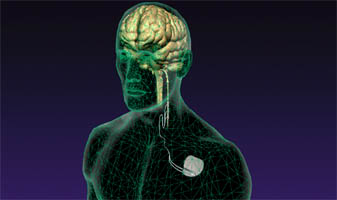- Wednesday 11th March 2015
Treatment for stroke victims shows ‘promising’ results

Them trial recruited 20 patients in Glasgow and Newcastle. Picture: John Devlin
TIM BUGLER
22:58 Tuesday 10 March 2015 00:00 Wednesday 11 March 2015
A GROUND-BREAKING new treatment to help stroke patients regain the use of their arms has shown “promising” results.
Vagus nerve stimulation (VNS) uses small doses of electricity to encourage the growth of new neural connections in the brain.
It has now been shown to help patients improve arm function by a greater degree than standard physiotherapy alone.
A stroke happens as a result of a loss of blood supply to a part of the brain, leading to tissue death and loss of functions controlled by the affected brain area. Around 85 per cent of stroke victims seen at the stroke clinic at Glasgow’s Western Infirmary have arm weakness, which persists to a significant degree in half of these.
The two-year trial, which recruited 20 patients in Glasgow and Newcastle-upon-Tyne with long-term arm weakness after their stroke, involved the implantation of a small electrical device into the body.
The device is similar to a pacemaker and is implanted in the chest. It is then connected to the vagus nerve in the neck using thin wires that are also implanted. Scientists decided to stimulate the vagus nerve as it connects to structures in the brain involved in recovery from injury. The idea was to take advantage of neuroplasticity – the natural ability of the brain to form new neural connections.
Pairing the vagus nerve stimulation with traditional rehabilitation encourages the brain to form new, stronger neural connections. The researchers in this study hoped this process would significantly improve arm function during the recovery process following the stroke.
The study recruited volunteers who had suffered ischaemic stroke at least six months earlier with moderately severe arm problems. The patients were split into two groups, one receiving intensive physiotherapy alone, the other receiving physiotherapy paired with VNS.
When patients followed the study protocol in full, there was a significantly greater improvement in a measure of arm function called the upper extremity Fugl-Meyer score.
The scores of VNS treated patients were six points higher than those who did not receive VNS in addition to their physiotherapy. When patients have such a large change in their score, noticeable improvements in arm related tasks can be observed on a daily basis.
Dr Jesse Dawson, of the Institute of Cardiovascular and Medical Sciences at Glasgow University, who led the trial, said: “Our initial study demonstrates that VNS paired therapy holds promise. Greater improvements in arm function were observed in patients using VNS paired therapy compared to participants using traditional rehabilitation alone.
“We need to do larger trials to confirm our findings and determine if the widespread adoption of this technique could benefit post-stroke patients with upper limb deficits. These initial results are certainly encouraging and warrant further investigation.”
The trial was run with Texas-based biomedical company MicroTransponder, which developed the “Vivistim” device.
http://www.scotsman.com/news/health/treatment-for-stroke-victims-shows-promising-results-1-3715354

